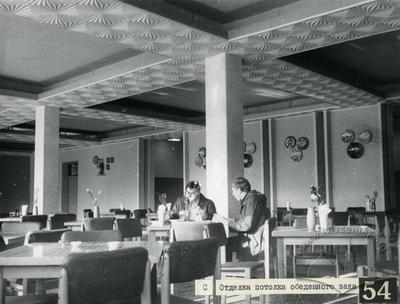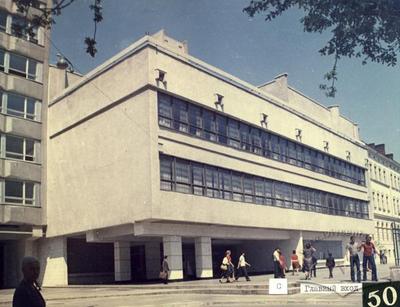Vul. Karpinskoho, 8 – Student Refectory of Lviv Polytechnic National University
ID:
2229
The refectory at Lviv Polytechnic National University (prior to 1993, Lviv Polytechnic Institute) was built between 1927-78, designed by Ivan Petryshyn and Victor Kravtsov in a Modernist style. The building houses cafeterias, a student dining room seating 850, and a food storage area. As of 2013, the structure retains its original function.
Architecture
The refectory building of the canteen is a part of the Lviv Polytechnic campus which is comprised of buildings # 1, 2, 3, 4, 5, refectory, and library. All the buildings except #3 were built between 1960-70. The refectory building is located in the pedestrian section of Karpinskoho Street between buildings # 2 and # 3, and faces Karpinskoho Street. A small internal square paved with concrete slab fronts the entrance. The building has three additional side service and employee entrances, as a loading dock approach to the food storage area located in the basement of the building. This underground level is linked to the network of underground passages connecting it to other campus buildings.
The structure was erected between the already existing Buildings #2 and #3, and abuts Building #3, forming an internal service yard. The above-ground vertical section of the structure consists of three main objects. The ground floor is set back, with the two-floor superstructure overhanging it. The upper section of the building is also set back, rendering it invisible from ground level, and making the builder appear lower than it is in order to correspond better with its surroundings.
The building interior is divided into public access and restricted service areas, each section with dedicated elevator and staircases. The first floor is occupied by a lobby, a small cafeteria seating 70, a cloakroom, as well as kitchen pantry, administration offices, a nurse’s office, and archive. Canteens and kitchen facilities are located on the second and third floors of the building. The top floor is comprised of a conference room, service facilities, and two open terraces.
The basement level holds food storage areas, walk-in freezers, and service areas. In this area on the building’s north side, food supplies are delivered at a long loading dock.
The main staircase is arranged so that its landings coincide with the stories of neighboring Building #2, directly connecting the two structures.
The building is constructed of prefabricated reinforced concrete slab in a standard 6x6 meter framing. The walls are constructed of brick and sheetrock. The facades of the building are marked by elements characteristic of this construction – columns, cross-beams, etc., which, in combination with rows of curtain windows gives the building its sculptured feel. The facades are finished in stucco. On the interior, the lobby and staircase are done in faux marble. The common rooms have floors of concrete slab mosaic; technical and service rooms are laid in ceramic tile.
Related Places
Personalities
Ivan Petryshyn (1940–1993) – 1967 graduate of Lviv Polytechnic Institute. Has taught at the Institute’s Urban Construction Department.
Between 1968-1990 Petryshyn’s designs were used in more than built 20 constructions, including:
Sports complex at Lviv Polytechnic resort camp with a dormitory sleeping 250, and main building with refectory seating 500
Dormitory at the Lviv Polytechnic Institute geodesic testing grounds in Berezhany
Lviv Polytechnic Institute Student refectory, seating 850
Residential apartment block for 72 flats on Boichuka Street in Lviv
Victor Kravtsov – architect, professor at Lviv Polytechnic. Born 1929 in Novosibirsk, Russia. His father was a journalist. After finishing high school in Rivne in 1947, Victor entered Lviv Polytechnic Institute and majored in architecture at the Institute’s construction department. From 1956 he worked at the Uzhorod OblProject where he designed residential buildings, indoor markets, the reconstruction of the city’s main square, its embankment, and the philharmonic concert hall. Other significant projects from his pen include the landscape design of Crimea’s Alushta Valley, Lviv’s Striyskyi Park, and Uzhhorod’s forest park. He received an Award for the development of Ukrainian resort and recreational infrastructure from the State Science and Technology Committee.
He was engaged in theoretical work in economic development related to urban construction and landscape design. He was commissioned by Lviv City Council to conduct research on the technical and fiscal rationale for an intra-park road system.
In 1970s Victor organized an architectural research lab under the Lviv Polytechnic Institute Student Planning and Design Bureau. It was concerned with the design of planned educational facilities. The design of a model 21st-Century University created by the lab was exhibited in Berlin.
Sources
1. Hofer A., Leitner E., Tscherkes B. Lemberg: Architecture and City. 100 Landmark Buildings. Vienna: Lit verlag GmbH & Co KG, 2012. p163
2. Proskuryakov, V. “The Creative Contribution of the Lviv Architechtural School Faculty in the Formulation of Lviv Architecture of the 1960s – 1980s.” Experience and Development Perspectives of Ukrainian Cities. Compendium of Scientific Writings, vol. 11. Kyiv: DiproMisto, 2006. p.109.
3. Lviv Polytechnic Institute Student Planning and Design Bureau. Order of Lenin Academic Lviv Campus Complex. Project element schematic – Student Refectory for 850 with Centralized Food Warehouse. Lviv: 1978. p20.
4. Biriulyov, Yuryi, ed. Architecture of Lviv: Times and Styles, 13th-21st centuries. Lviv: Center of Europe Publishing, 2008. pp624-720.
Material Assembled by Andriy Shulyar
Media Archive Materials
Related Pictures
















